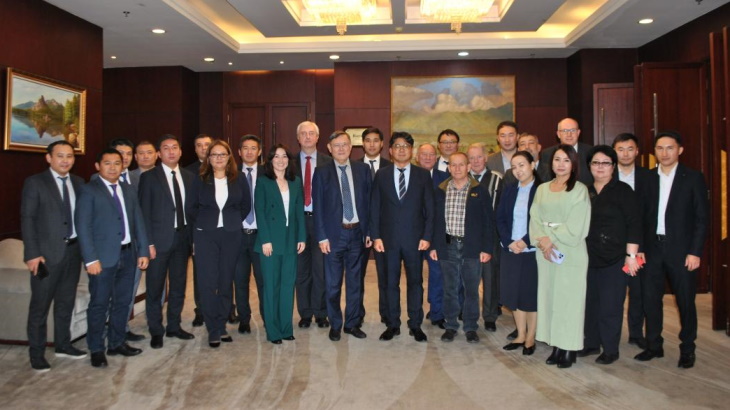IAEA assesses Kazakh plant site selection process
The International Atomic Energy Agency (IAEA) has concluded a five-day Site and External Events Design (SEED) mission to Kazakhstan to review the country's process for selecting the site of a planned nuclear power plant.

The IAEA SEED mission with Kazakh representatives (Image: Kazakh Ministry of Energy)
Kazakhstan's Ministry of Energy has proposed the potential reintroduction of nuclear power to reduce the country's reliance on fossil fuels, diversify its energy mix and reduce CO2 emissions. Kazakhstan Nuclear Power Plant (KNPP), which has been designated as the owner/operator of the future plant, began preparing a feasibility study in 2018 to justify the need for nuclear power, the choice of the location for plant construction and to review the plant's projected power output.
In August, the Ministry of Energy issued an update on progress towards the construction of the plant, confirming the selection of Ulken in the Zhambyl district of Almaty region as the most suitable area for the plant, with Kurchatov as a backup region.
Kazakhstan requested the IAEA conduct a SEED review mission to assess the process for making the site decision. The SEED mission - comprising experts from Turkey and the UK as well as two IAEA staff - took place from 2-6 October.
Designed to assist IAEA Member States at different stages in the development of a nuclear power programme, the SEED safety review service offers a choice of modules on which to focus the review, such as site selection and assessment, and the design of structures, systems and components against site external hazards. In the case of site selection review, SEED missions do not assess the actual site chosen, but the appropriate consideration of the safety issues in the site selection process.
The objective of the SEED review mission was to support Kazakhstan on the finalisation of its Prefeasibility Study Report (PFR), on the basis of applicable IAEA safety standards. The review focused on the quality of data in the site selection report and data collection methods, the appropriateness of the site selection process, and hazard modelling, with reference to the construction of two units at a selected site.
The IAEA team found no definitive evidence of safety-related issues associated with exclusion criteria (typically fault capability, ground collapse, feasibility of emergency planning, etc.) which would have suggested the unsuitability of both the proposed regions and sites within them (in Ulken and Kurchatov regions, respectively). The team suggested KNPP carry out a limited additional data collection campaign to minimise the generic risk that potential safety issues might surface at later stage.
"The decision to embark on the development of nuclear energy is a momentous one, and it underscores our nation's commitment to diversify our energy resources while upholding the highest standards of safety and environmental responsibility," said Gumar Sergazin, Director of the Department of Atomic Energy and Industry. "I am confident that the outcomes of this SEED will not only contribute to the safety and sustainability of our nuclear energy programme but will also further strengthen the bonds of cooperation and trust among all stakeholders involved."
The final mission report will be delivered to the Kazakh government within three months.
Four foreign potential suppliers of nuclear technology are being considered by Kazakhstan. These are EDF of France, China National Nuclear Corporation, Korea Hydro & Nuclear Power and Rosatom of Russia.
A Russian-designed BN-350 sodium-cooled fast reactor operated near Aktau in Kazakhstan for 26 years until 1999, generating electricity and desalinating water. Kazakhstan currently operates research reactors as well as several other nuclear installations related to the front end of the nuclear fuel cycle, including uranium mining.
Researched and written by World Nuclear News
- China Institute of Atomic Energy
- Nuclear Power Institute of China
- Southwestern Institute of Physics
- China Nuclear Power Operation Technology Corporation, Ltd.
- China Nuclear Power Engineering Co., Ltd.
- China Institute for Radiation Protection
- Beijing Research Institute of Uranium Geology (BRIUG)
- China Institute of Nuclear Industry Strategy (CINIS)
- China Nuclear Mining Science and Technology Corporation


